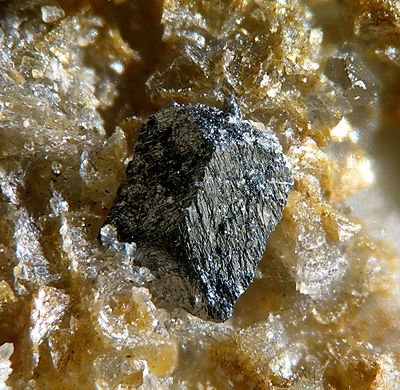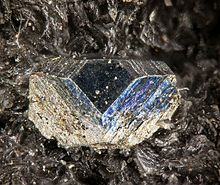Filling pit
| Filling pit | |
|---|---|
| Fülöppit from the type locality Kreuzbergstollen ( Dealul Crucii ), Romania (image width 1 mm) | |
| General and classification | |
| chemical formula | Pb 3 Sb 8 S 15 |
|
Mineral class (and possibly department) |
Sulfides and sulfosalts |
|
System no. to Strunz and to Dana |
2.HC.10a ( 8th edition : II / E.21) 06/03/20/01 |
| Crystallographic Data | |
| Crystal system | monoclinic |
| Crystal class ; symbol | monoclinic prismatic; 2 / m |
| Room group (no.) | C 2 / c (No. 15) |
| Lattice parameters |
a = 13.44 Å ; b = 11.73 Å; c = 16.93 Å β = 94.7 ° |
| Formula units | Z = 4 |
| Physical Properties | |
| Mohs hardness | 2.5 (VHN 100 = 140 to 157) |
| Density (g / cm 3 ) | measured: 5.22; calculated: 5.19 |
| Cleavage | not defined |
| Break ; Tenacity | uneven; brittle |
| colour | lead gray |
| Line color | reddish gray |
| transparency | opaque |
| shine | Metallic luster |
Fülöppit is a rarely occurring mineral from the mineral class of "sulfides and sulfosalts". It crystallizes in the monoclinic crystal system with the chemical composition Pb 3 Sb 8 S 15 , so it is a compound of lead , antimony and sulfur , which structurally belongs to the sulfosalts .
Fülöppit is opaque in every form and usually develops short prismatic or pyramidal crystals with partially striped and metallic shiny surfaces. Fülöppit is generally lead-gray in color, but can also appear steel blue or bronze white on polished surfaces. However, the mineral leaves a reddish-gray line on the marking board .
With a Mohs hardness of 2.5, Fülöppit is still one of the soft minerals that can no longer be scratched with a fingernail like the reference mineral gypsum (2), but easier than the reference mineral calcite (3) with a copper coin.
Etymology and history
Fülöppit was first discovered in the Kreuzberg tunnel ( Dealul Crucii , Kereszthegy ) near Baia Mare in northwest Romania and described in 1929 by I. de Finály and Sándor Koch, who named the mineral after its discoverer, the Hungarian lawyer, statesman and mineral collector Béla Fülöpp (1863– 1938), named.
classification
Already in the outdated, but partly still in use 8th edition of the mineral classification according to Strunz , the Fülöppit belonged to the mineral class of "sulfides and sulfosalts" and there to the department of "sulfosalts (S: As, Sb, Bi = x)", where it belongs together with heteromorphite , plagionite , rayite and semseyite formed the unnamed group II / E.21 .
The 9th edition of Strunz's mineral systematics , which has been in effect since 2001 and is used by the International Mineralogical Association (IMA), classifies the Fülöppit in the department of "Sulphosalts with SnS as a model". This is further subdivided according to the predominant metals in the compound, so that the mineral can be found according to its composition in the sub-section "Only with lead (Pb)", where it is the only member of the unnamed group 2.HC.10a .
The systematics of minerals according to Dana , which is mainly used in the English-speaking world , assigns the Fülöppit to the class of "sulfides and sulfosalts" and there in the department of "sulfosalts". Here it is together with heteromorphite, plagionite, rayite and semseyite in the " Fülöppit group (monoclinic: C 2 / c contains Pb, Sb) " with the system no. 06/03/20 within the subsection “Sulphosalts with the ratio 2.0 <z / y <2.49 and the composition (A + ) i (A 2+ ) j [B y C z ], A = metals, B = semi-metals , C = non-metals ”.
Education and Locations
Fülöppit is formed by hydrothermal processes . Andorite , boulangerite , cinnabarite , dolomite , fizélyite , free lifeite , geokronite , jamesonite , marcasite , quartz , semseyite , sphalerite and zincite can be used as accompanying minerals .
As a rare mineral formation, Fülöppit could only be detected at a few sites, whereby so far (as of 2014) around 50 sites are known. In addition to its type locality Kreuzbergstollen ( Dealul Crucii , Kereszthegy ) and the nearby Herja Mine near Baia Mare in the Maramureș district, the mineral also appeared in Romania at Săcărâmb (also Sacarîmb , Sãcãrâmb , Szekerembe and formerly Nagyág ) in the Hunedoara district .
The "La Forge Mine" in the commune of Anzat-le-Luguet in the French department of Puy-de-Dôme (Auvergne), where crystals of up to seven millimeters in length emerged (otherwise generally around three millimeters), is known for its extraordinary Fülöppit finds. .
In Germany, the mineral has so far been found in several places in the Black Forest such as the Ursula mine near Welschensteinach , the Artenberg quarry near Steinach (Ortenaukreis) and in some places in the vicinity of Sulzburg in Baden-Württemberg. It was also found in the Graf Jost-Christian colliery near Wolfsberg (Sangerhausen) and Dietersdorf (southern Harz) in Saxony-Anhalt as well as in the council quarry near Hartmannsdorf (near Chemnitz) and in the New Hope mine near Bräunsdorf in the district of Central Saxony.
Other sites are in Bolivia, Bulgaria, China, Greece, Canada, Kazakhstan, Luxembourg, Slovakia, Spain, the Czech Republic, Ukraine, the United Kingdom (England) and the United States of America (Arkansas, Colorado).
Crystal structure
Fülöppit crystallizes monoclinically in the space group C 2 / c (space group no. 15) with the lattice parameters a = 13.44 Å ; b = 11.73 Å; c = 16.93 Å and β = 94.7 ° and 4 formula units per unit cell .
See also
literature
- I. de Finály, Sándor Koch: Fülöppite, a New Hungarian Mineral of the Plagionite-Semseyite Group. In: Mineralogical Magazine. Volume 22 (1929), pp. 179-184 ( PDF 230.8 kB )
Web links
Individual evidence
- ↑ a b c d e Hugo Strunz , Ernest H. Nickel: Strunz Mineralogical Tables . 9th edition. E. Schweizerbart'sche Verlagbuchhandlung (Nägele and Obermiller), Stuttgart 2001, ISBN 3-510-65188-X , p. 136 .
- ↑ a b c Fülöppite , In: John W. Anthony, Richard A. Bideaux, Kenneth W. Bladh, Monte C. Nichols (Eds.): Handbook of Mineralogy, Mineralogical Society of America , 2001 ( PDF 64.1 kB )
- ↑ Mindat - number of locations for Fülöppit
- ↑ Mindat - Examples of Fülöppiten from the La Forge Mine, Anzat-le-Luguet, Puy-de-Dôme, Auvergne, France
- ↑ Find location list for Fülöppit at the Mineralienatlas and at Mindat

